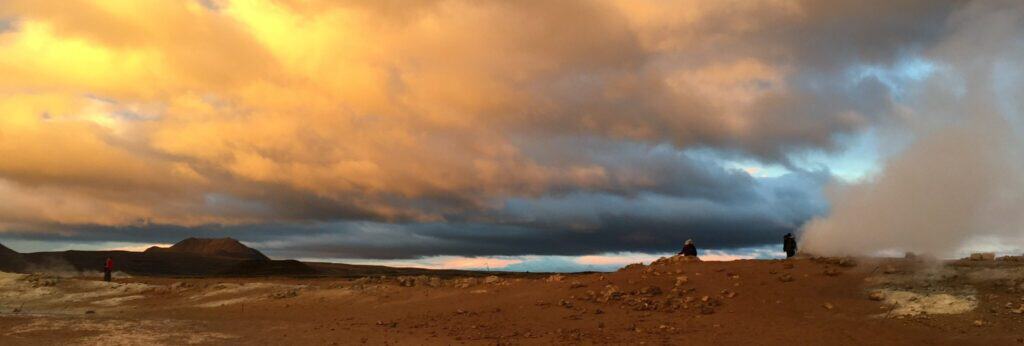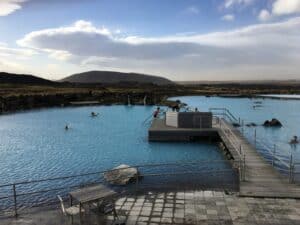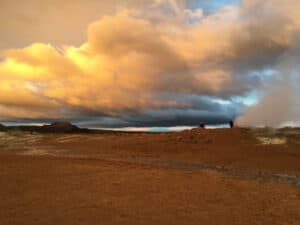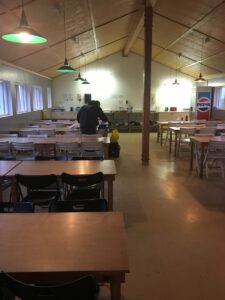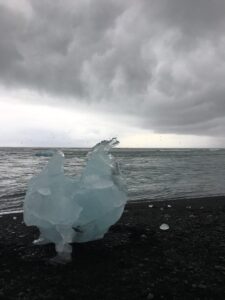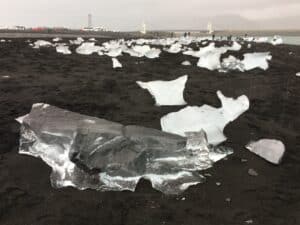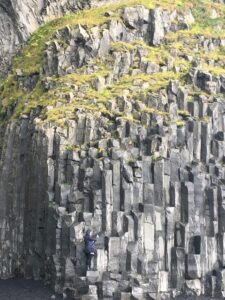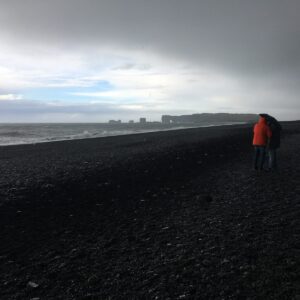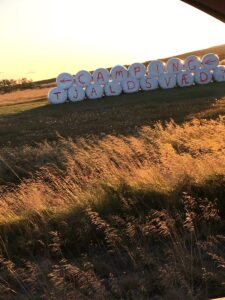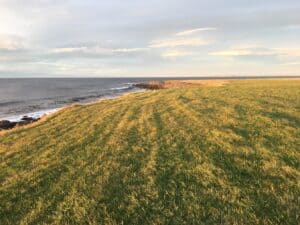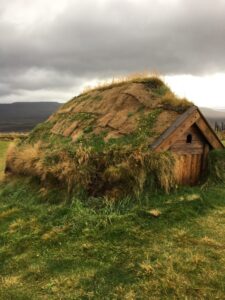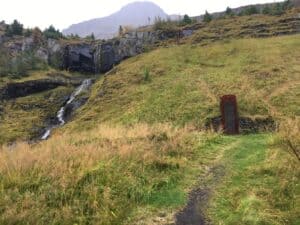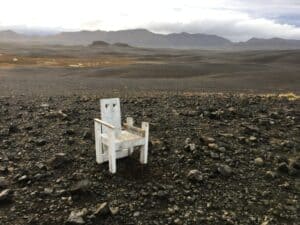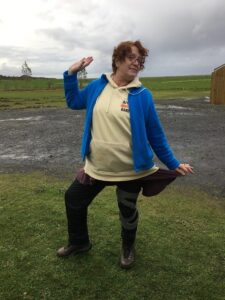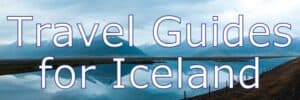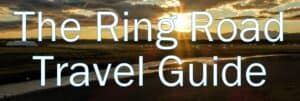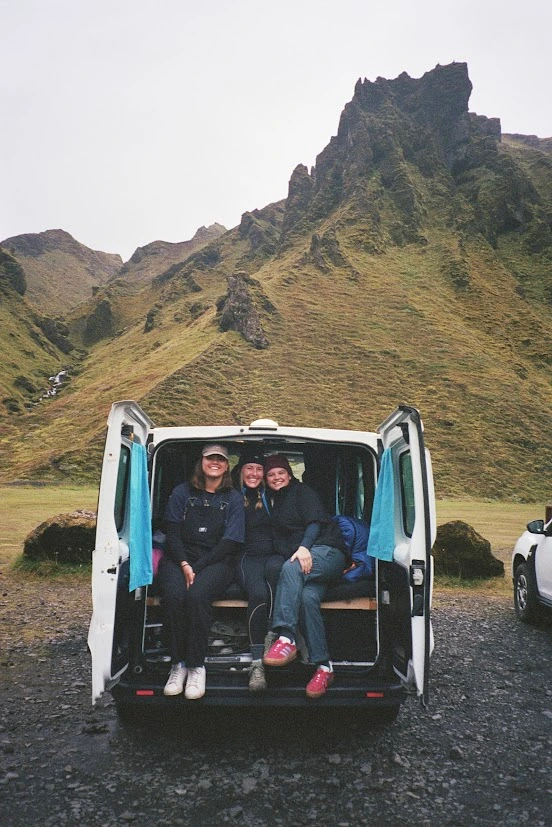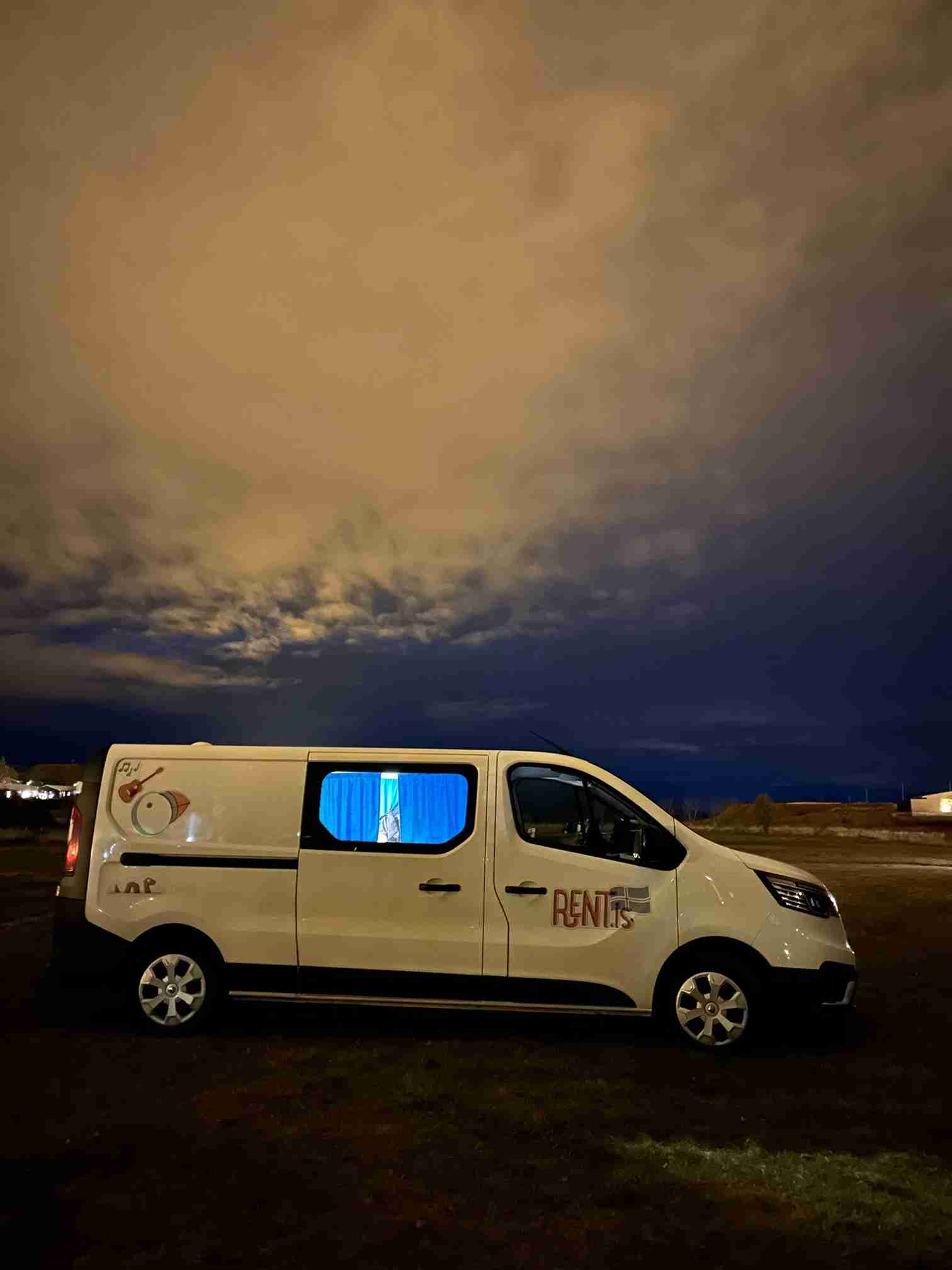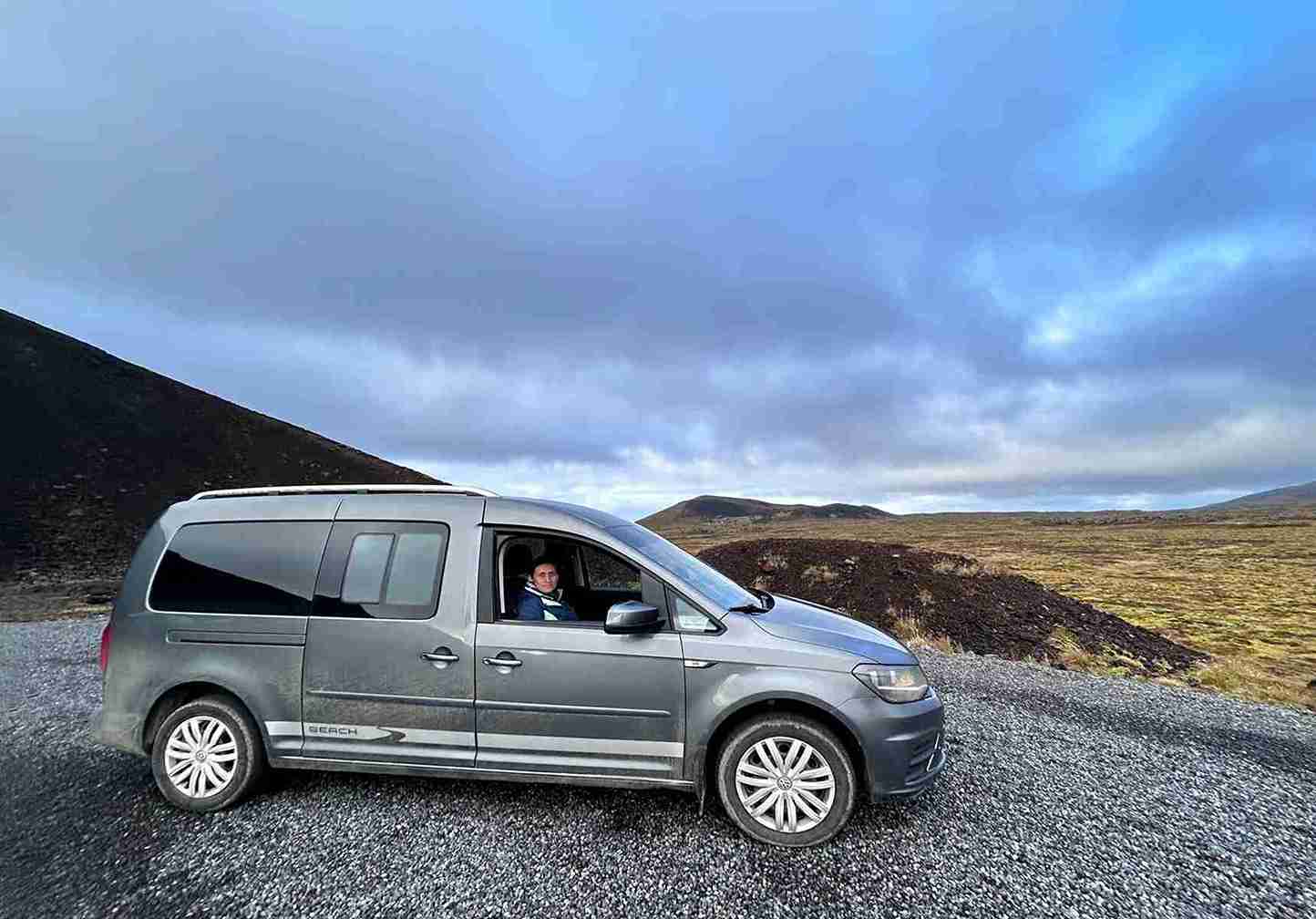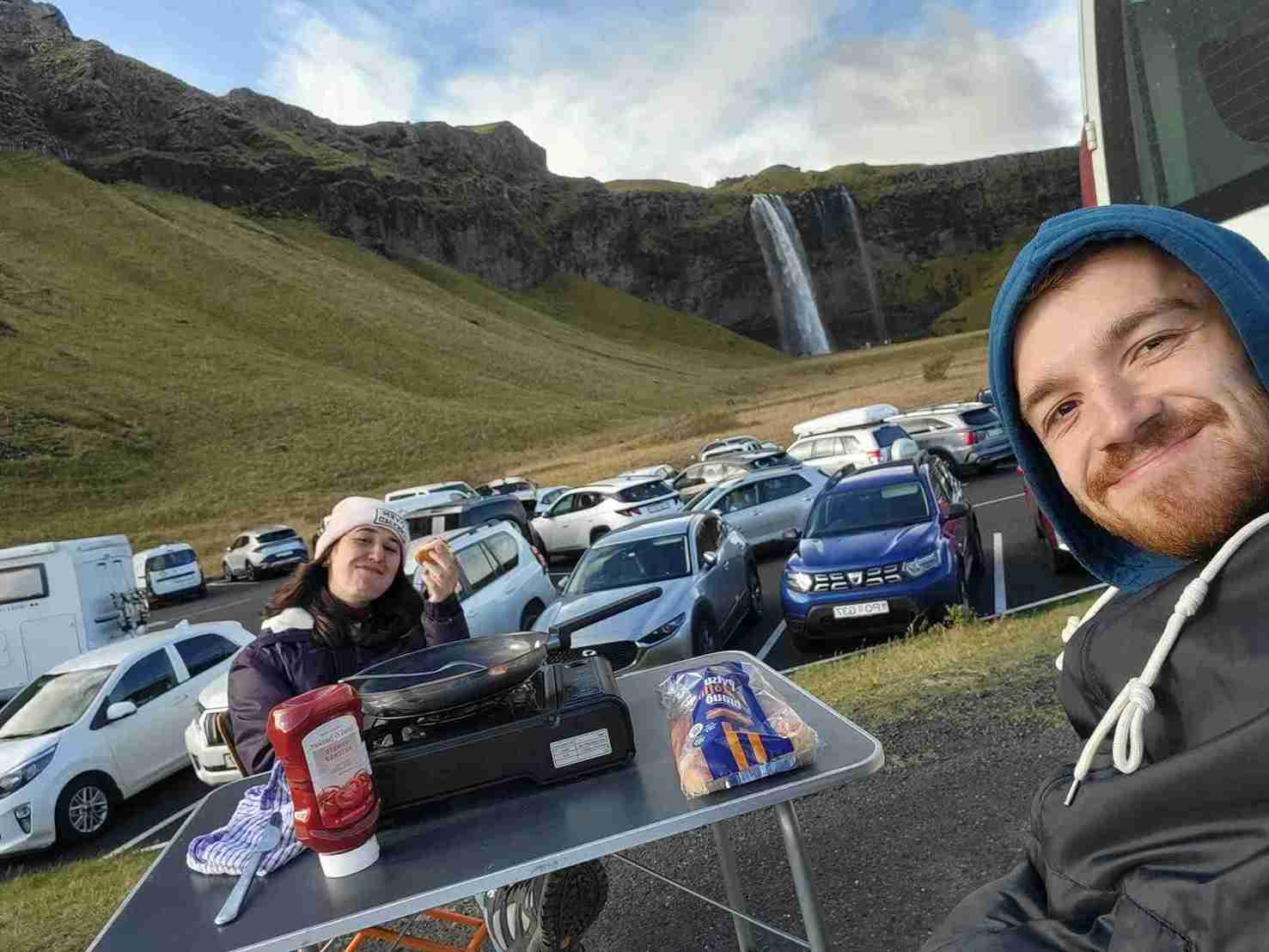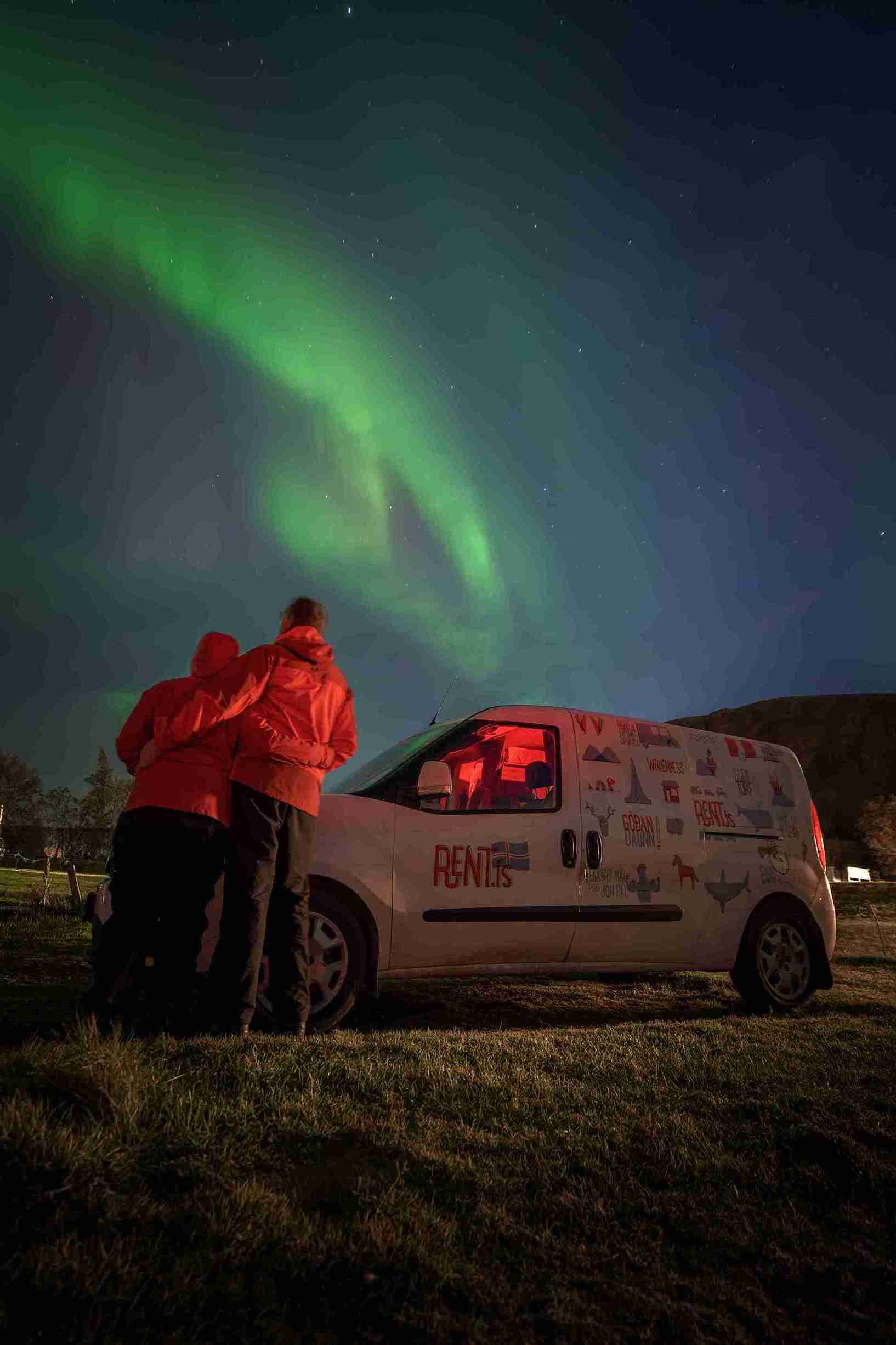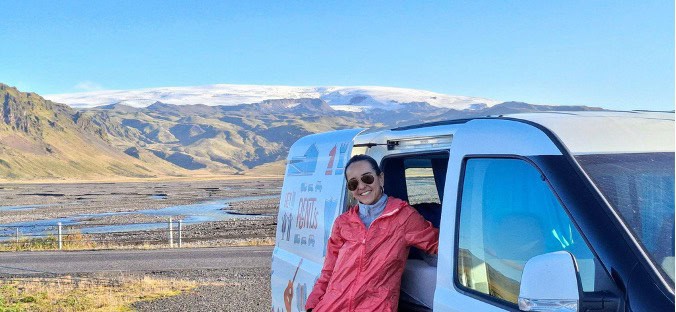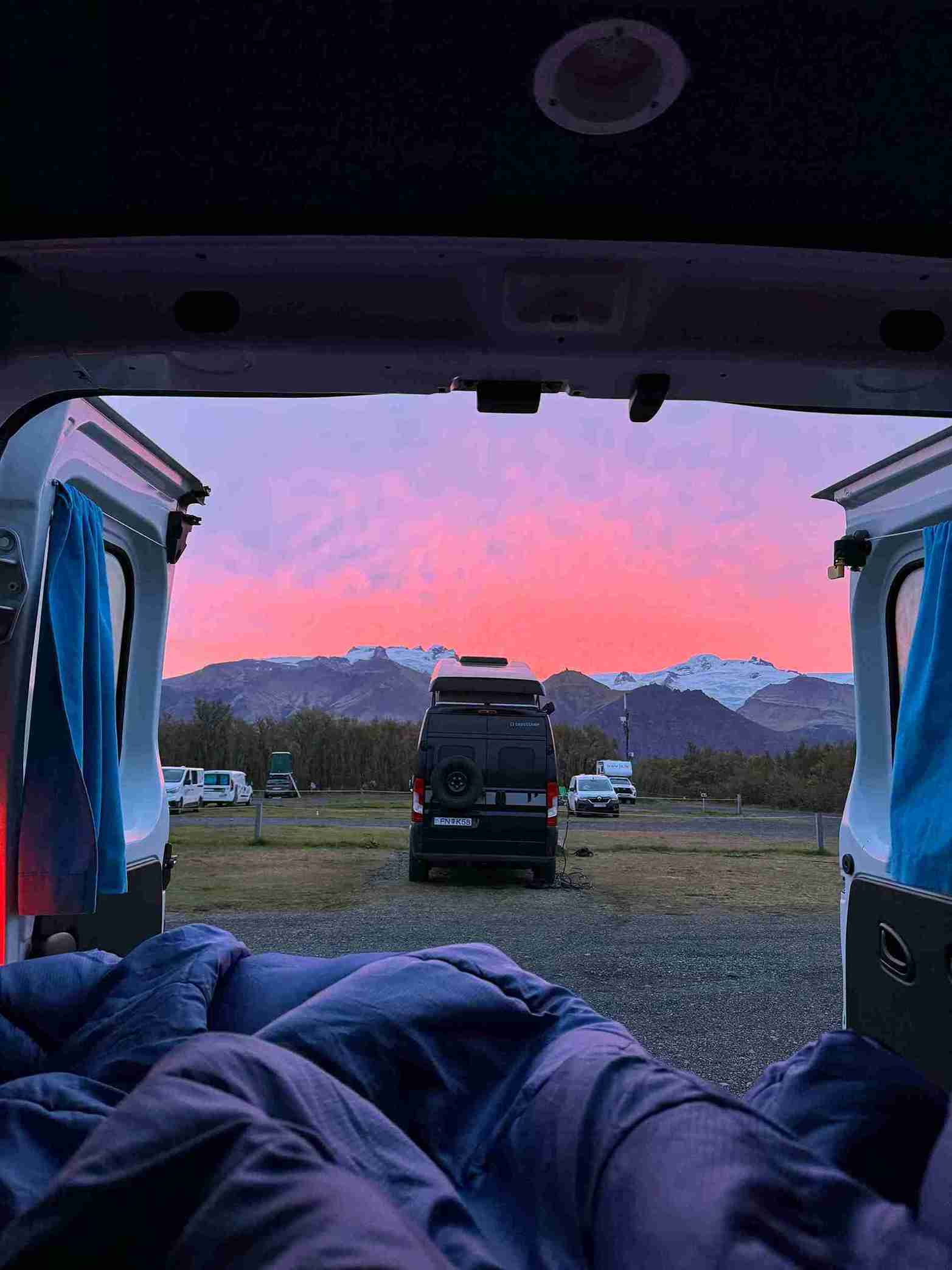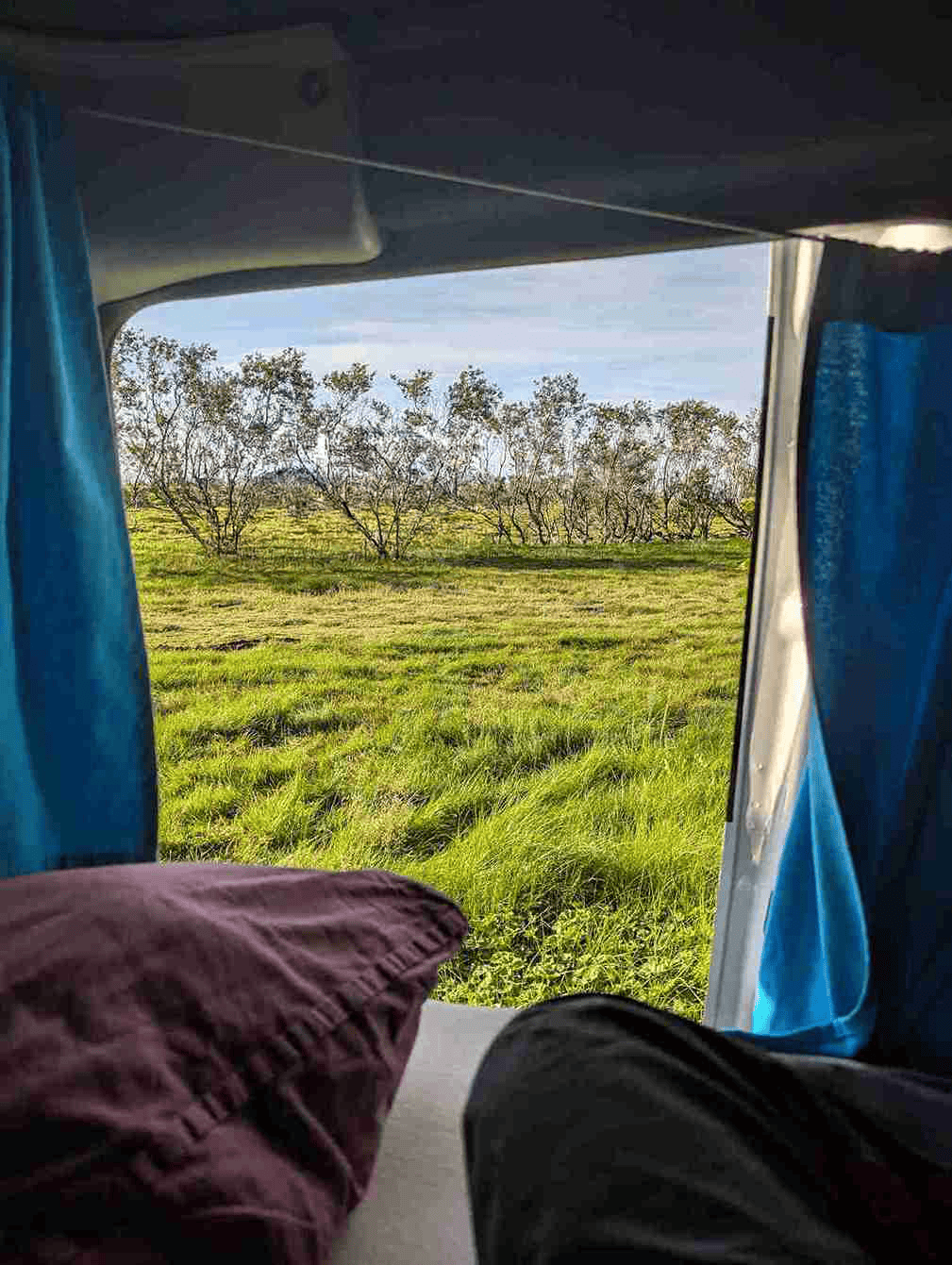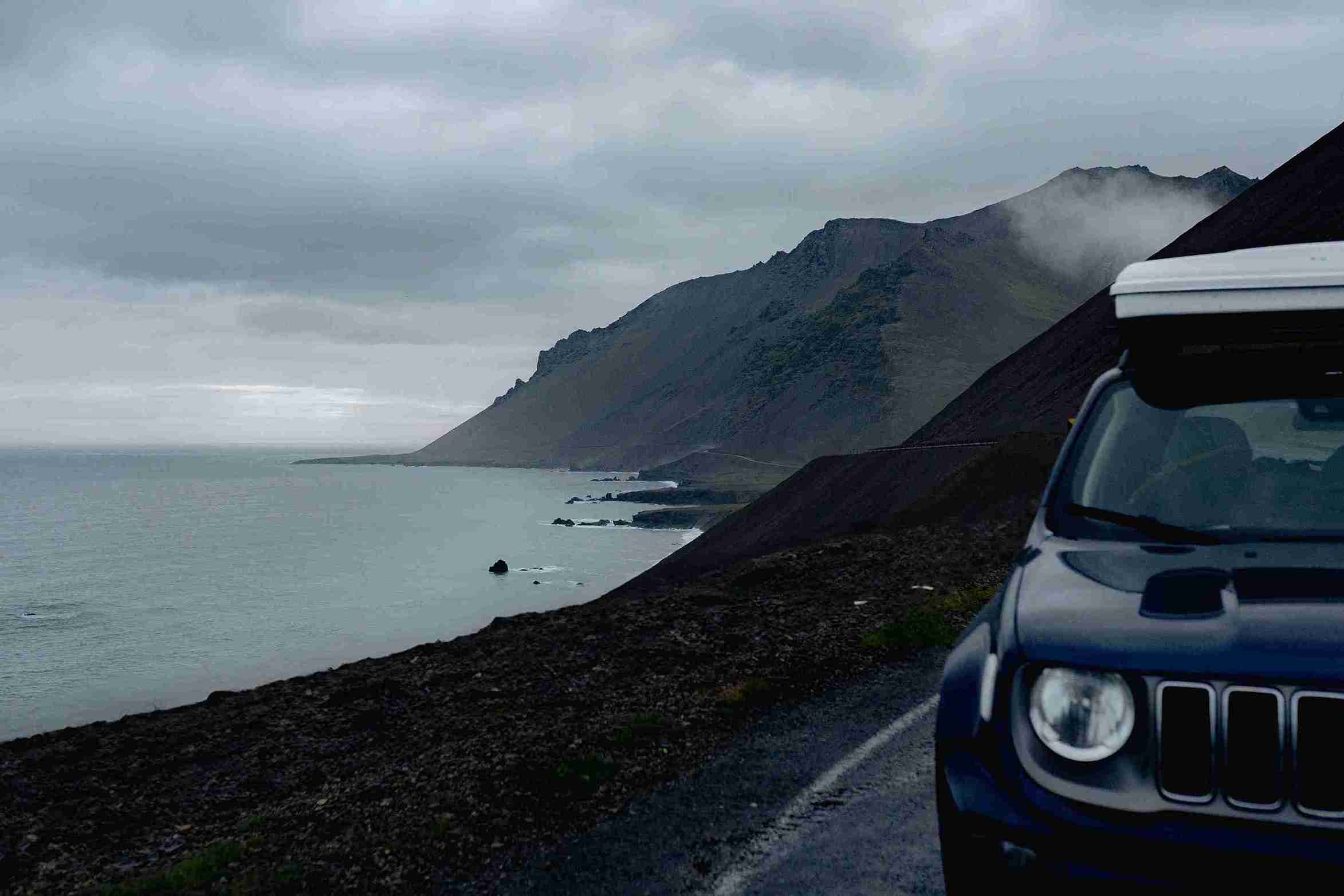Aside from our introductory night in Vik, where else did we go and what else made an impression on us? It was all a blur of beauty and discovery. Never a dull landscapes. Jaw-dropping views and finds. Few trees, but marvelous undulating rocks, sheep, wind-whipped horses, charming red roofed churches, marshmallow fields, rainbows, waterfalls & black sand beaches. We particularly enjoyed the Mývatn area. The geothermal region (Skútustaðahreppur) is hauntingly beautiful, especially at sunset and we had been told to skip the crowded Blue Lagoon and go instead to the Mývatn Baths .
I love these things, and my husband is not normally a fan, but he good naturedly agreed to accompany I mean, we ARE in Iceland after all and can’t miss this! We were told when we arrived that because of a storm the night before that the waters were colder than usual, so everyone was being given a discount. Score! We LOVED the experience! It was interesting wearing a swimsuit and hurriedly walking to the sauna and then the pool while that lucky lifeguard was all bundled up for the cold windy day that it was. So relaxing and calming, and the view was great! Even my hubby enjoyed it!
Mývatn Nature Baths
Geothermal area near Mývatn
One place that we loved we stumbled upon while traveling eastward from Vik on our way to the ever-changing and spectacular Jökulsárlón. The previous night, we spent in a beautiful, uncrowded and clean campsite in the area of Hornafjörður municipality. Run by a farmer, it was surrounded by hills and sheep .
Campsite kitchen area
In the morning, as we approached Jökulsárlón, we noticed several cars and tour buses parked off the main road by the ocean. Curious, we turned and were shortly rewarded with the surreal sight of large chunks of glimmering ice from Jökulsárlón that had floated out to sea and were carried to the black sandy beach we now stood on, this area called Sveitarfélagið Hornafjörður.
Also, a sight to not be missed was on the way and close to Vik – were the black stone beaches of Reynisfjara and the striking columns of basalt, like organ pipes at the cave of Hálsanefshellir.
At Bakkagerði, we stopped for a hot lunch on an exceptionally cold and windy day. After the fiasco of the dried fish jerky, we were a tiny bit hesitant to try the fish soup, but remembered that every restaurant in Iceland worth its salt has it on the menu, and we ordered it. It was outstanding: flavorful, hot and comforting. We dipped bread and looked out the window, nice and warm and well-fed. With warmth in our tummy, we scaled the small hill of Álfaborg, the Palace of the Elves, which is the residence of the Iceland elf-queen, Borghildur, and were rewarded with a panoramic view of the charming area.
Northern Lights: What we learned
As I mentioned the “season” begins mid-September. And that was a key reason why we chose to arrive this time of year. At campgrounds and tourist information sites (commonly found by key spots) we heard several stories – not sure how reliable- that the best viewing time is from 9:30-10:30 or not all night. Hmmmmmm. Also, heard that colors vary, depending on… oh, I can’t explain it well. In short, look for clear nights. There is an Aurora forecast app which will predict the likelihood of viewing. If you are serious and on a time crunch, note the day that the viewing is predicted to be rather good and stay away from any lighting or trees.
Don’t expect to see lots of greens or violet or pink. We just saw some milky gray and brilliant white, but what a light show! Our first look was an unexpected one while at a campsite in Egilsstaðir. The campsite has trees and buildings around it with bright lights. The forecast was for rain, and the prediction from the app was for a very low viewing probability. So, we were tucked in and suddenly heard some excited talk from fellow campers nearby. It was around 9:20 (much to our amusement) We rolled up the shades and saw some lighting in the sky. Had I not known that this was the Aurora Borealis I would have imagined us by a large city with lights reflected on low hanging clouds, with the type of beacon that one uses to promote special events (like Hollywood premieres) The big show (which we had heard to expect) was several nights away, so we were happy to witness a little introduction.. We just stared at the slightly lighting sky, not really that terribly impressive until we see one beam just do a sudden twirl. Fun!
The real deal that we were ready for came several night later. We had planned to stay the night in Húsavik in order to go whale watching the next morning. But, the campsite there was by a soccer stadium, surrounded by structures that would obscure a good viewing, so we continued to look for a place to stay. We had two choices. One was a campsite about 15 or so kilometers further on, which we drove to and could not find, despite following signs. Perhaps it was closed already for the season. The other option was a farm that we had passed about 15 kilometeres before Húsavik, which sat on a beach., with an open sky! The campsite was announced by a sign handwritten on the “marshmallows” (Camping Tjaldsvæði) in the area of Tjörneshreppur. We returned there and were rewarded by a beautiful open sky to best view the AB.
Each campsite that we visited had a communal kitchen, toilets, and if lucky, hot showers. The more crowded the campsite, the less clean the showers and kitchen area, despite signs asking campers to clean up your mess and area. (This was really only the case in Vik and Reykjavik) This farm campsite was new, very clean and still without showers, but we saw that they were preparing to install them. The young owner had been hanging laundry as we drove up, and she approached with a warm smile. Not only does she live there, but here grandparents have a small home, too.
We were one of three vans/tents camped there that night, including a cute young couple from Hungary, on their honeymoon. We had a glorious unobstructed view of the sky, the beach and the Northern Lights which for the record started at 8:30, moved a lot and rapidly for about an hour and a half in shades of gray and bright white, and then calmed down. Very moving and super cool to watch. Very surreal.
Driving and animals
One problem with driving in Iceland is that there is SO much to see and admire while driving. But, stopping on the road is not allowed, and sadly, there are no shoulders built into the road to pull over when you spy something fantastic, so if you miss it, that’s it! The opportunities to turn around are slim, too. Sadly, missed taking a lot of good pictures this way and enjoying a view. DO stop and turn off at the road signs for places of interest. Always worthwhile! Here is a picture of Geirsstaðir church in Hróarstúnga.
Also,be on the lookout for rogue sheep, who sometimes don’t stay behind the fence. Speaking of animals, there are (but we did not see) reindeer, Arctic foxes and Puffins (too late in the season). We DID see swans and geese who stood out on the green gold landscape with their bright white feathers.
Signs of quirkiness
Phone booth on hill just past Seyðisfjörður.
White chair placed in the middle of nowhere near Fljótsdalshérað. (on the way to Mývatn.)
What to wear?
The rain- often horizontal due to the ever-blowing winds, was pretty much relentless. We were prepared to bundle up! We wore several layers at once: long sleeved warm shirt, pullover sweater or hooded sweatshirt, fleece jacket and a hooded rain jacket. As needed, gloves, scarf and hat. Pants were either jeans or long stretchy yoga-type, topped with a protective layer of waterproof pants, which, happily I had found in the US for about $15 a pair for each of us. We did not need to buy the expensive super warm ones; these windbreaker-type material ones were GOLD! DON”T FORGET HIKING BOOTS! And a pair or two of hiking socks. Your feet will stay toasty and dry. Mud will not be something to fear.
Do try to pack lightly. You can wear the same thing for 2-3 days, with the exception of underwear and socks, which can be washed out and left to dry for a couple of days. This is where a cord would have come in handy to string up. Since it wasn’t hot out, did our clothes stink? Hmmm…maybe we were a little ripe. But, then again, we were in our element, fitting in with everyone else who camps. In the end, we were quite warm and dry, I am happy to say. Another tip: I made it a point to pack a couple of items of clothing that I planned to part with. You know, that faded sweatshirt that is 12 years old, stretched -out jersey shirts, etc. It was nice to toss these things at the end of the trip, knowing I might have room for something else that I found on our travels to bring back.
What else to pack (that no one told you about) ?
We learned that aside from your own dishtowel and sponge, and a Michelin map, the following come in handy:
- Microfiber towels (purchased at REI, if in the US)- one large (showers) and one small
- Paper towels
- Tissues (wind and cold= runny noses)
- Small plastic bags for trash rubber bands (to seal food packages)
- Cord to serve as a clothesline
- Hand cream
- Lip balm
- Small flashlight and batteries
- Swiss army knife- just because they’re cool
- Flip flops or Crocs for showers
Make sure to include pictures of:
Rainbow pics, black sand beaches with basalt, campsite kitchen, me (dressed camper), black sand beaches with ice, marshmallow farm, Mývatn Bath, geothermal area, sheep on cliff, white chair and phone booth. Soup and lamb and butter, picture of camping near Húsavik with the marshmallow sign
Hope you all have fun and make wonderful memories!
“There are no good pictures of Iceland” – Part 1
Read more: Nick & Rob’s adventure around Iceland
Happy Camping! #CamperStories
Iceland Travel Guides
If you like what you see, please subscribe to our YouTube channel!

